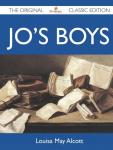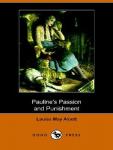Jack And Jill
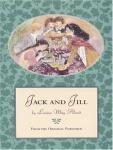
When best friends, Jack and Jill, tumble off their sled, their injuries cause them to be bedridden for many months. Their parents fill their days with the joys of Christmas preparations, a theatrical production and many other imaginative events.
Related Books
Author other works
-
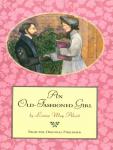
An Old-Fashioned Girl
Louisa May Alcott
An Old-Fashioned Girl is a novel by Louisa May Alcott.It was first serialised in the Merry's Museum magazine between July and August in 1869 and consisted of only six chapters. For the finished product, however, Alcott continued the story from the chapter "Six Years Afterwards" and so it ended up with nineteen chapters in all. The book revolves around Polly Milton, the old-fashioned girl who titles the story. Polly visits her wealthy friend Fanny Shaw in the city and is overwhelmed by the fashionable and urban life they live––but also left out because of her "countrified" manners and outdated clothes.The novel was the basis of a 1949 musical film starring Gloria Jean as Polly.Polly Milton, a 14-year-old country girl, visits her friend Fanny Shaw and her wealthy family in the city for the first time. Poor Polly is overwhelmed by the splendor at the Shaws' and their urbanized, fashionable lifestyles, expensive clothes and other habits she has never been exposed to, and, for the most part, dislikes. Fanny's friends reject her because of her different behavior and simple clothing, and Fan herself can't help considering her unusual sometimes. However, Polly's warmth, support and kindness eventually win the hearts of all the family members, and her old-fashioned ways teach them a lesson.Six years later, Polly comes back to the city to become a music teacher and struggles with profession issues and internal emotions. Later in the book, Polly finds out that the prosperous Shaws are on the brink of bankruptcy, and she guides them to the realization that a wholesome family life is the only thing they will ever need, not money or decoration.With the comfort of the ever helpful Polly, the family gets to change for the better and to find a happier life for all of them. After being rejected by his fiancée, Trix, Tom procures a job out West, with Polly's brother Ned, and heads off to help his family and compensate for all the money he has wasted in frivolous expenditures. At that point of the book, we see that Polly and Tom seem to have developed strong feelings for one another.At the end of the book, Tom returns from the West and finally gets engaged to his true love, Polly.
-
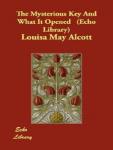
The Mysterious Key And What It Opened
Louisa May Alcott
When Paul spoke in that tone and wore that look, Lillian felt as if they had changed places, and he was the master and she the servant. She wondered over this in her childish mind, but proud and willful as she was, she liked it, and obeyed him with unusual meekness when he suggested that it was time to return.
-

Little Women
Louisa May Alcott
Little Women is a novel by American author Louisa May Alcott (1832–1888). The book was written and set in the Alcott family home, Orchard House, in Concord, Massachusetts. It was published in two volumes in 1868 and 1869. The novel follows the lives of four sisters – Meg, Jo, Beth, and Amy March – and is loosely based on the author's childhood experiences with her three sisters. The first volume, Little Women, was an immediate commercial and critical success, prompting the composition of the book's second volume, entitled Good Wives, which was also successful. Both books were first published as a single volume entitled Little Women in 1880. Alcott followed Little Women with two sequels, also featuring the March sisters: Little Men (1871) and Jo's Boys (1886). Little Women was a fiction novel for girls that veered from the normal writings for children, especially girls, at the time. Little Women has three major themes:" domesticity, work, and true love. All of them are interdependent and each is necessary to the achievement of a heroine’s individual identity."Little Women itself "has been read as a romance or as a quest, or both. It has been read as a family drama that validates virtue over wealth." Little Women has been read "as a means of escaping that life by women who knew its gender constraints only too well." Alcott "combines many conventions of the sentimental novel with crucial ingredients of Romantic children's fiction, creating a new form of which Little Women is a unique model." Elbert argued that within Little Women can be found the first vision of the "American Girl" and that her multiple aspects are embodied in the differing March sisters.
-
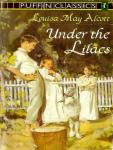
Under The Lilacs
Louisa May Alcott
Under the Lilacs is a children's novel by Louisa May Alcott, first published in 1878. The story is about two girls; Bab and Betty Moss; Miss Celia; a circus runaway, Ben Brown; and his dog Sancho.When Bab and Betty decide to have a tea party with their dolls a mysterious dog comes and steals their prized cake. The girls find a circus run-away, Ben Brown, hiding in their play barn. Ben is a horse master, so when the Mosses take the Ben in they find him work at a neighbor's house driving cows.Eventually Ben finds out his beloved father is dead. Miss Celia, a neighbor, comforts him and finally offers to let Ben stay with her and her fourteen-year-old brother Thornton.Many adventures and summer-happenings go on in Celia's house, as Ben slowly finds his place among his friends. Sancho gets lost, Ben is accused of stealing, Miss Celia gets hurt and Ben takes a wild ride on her horse, Lita. They have an archery competition, where Ben emerges as the hero. But a pleasant surprise is waiting for Ben in the end, and the story is an altogether heart - rendering tale of friendship and adventure, by celebrated authoress, Louisa May Alcott.
-
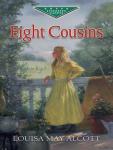
Eight Cousins
Louisa May Alcott
Eight Cousins is the wonderful story of Rose Campbell, whom we first meet as a sickly and despondent 13-year-old orphan. She is grieving for her recently dead parents, and she tends to get the vapors and other Victorian women's ailments. Nevertheless, this shy, frail and delicate creature is sent to live on the "Aunt Hill" to be raised by six very opinionated aunts. And that's not all. She is also surrounded by seven male cousins, as boisterous and full of life as they come. Rose's initial reaction is to wish herself dead. Barely able to lift her head, she is frightened and overwhelmed by the presence of her mischievous clan. But deep inside, she is secretly envious. The boys get to climb trees and run and play, while Rose, as all young women in her day, is confined to the parlor, constricted by tight corsets and impossible petticoats. Along comes Uncle Mac, the doctor uncle whose view of how to raise girls clashes with his day and time--and all six of his sisters, the formidable aunts. In the character of Doctor Mac, Louisa May Alcott was able to tout her own family's avante garde views on women's health, almost a century ahead of its time. The doctor forbids Rose to wear the constricting corsets, to the horror of all her aunts and the girl herself. He wonders how she can feel healthy when she cannot draw a decent breath? He encourages her to play outside with her cousins, to get fresh air and exercise. He demands that she eat good, hearty meals instead of womanly morsels. And under his tutelage, and with the friendship of her wonderful cousins, Rose starts to bloom. She turns from a shy, sickly little mouse into a strong, outgoing young woman.
